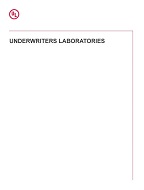
UL 1655
Click here to purchase
Please note: All interim revisions for this edition available at time of your purchase will be included.
Community-Antenna Television Cables
UL 1655
1 Scope
1.1 This Standard states the construction, test, and marking requirements covering the safety of single and multiple coaxial and coaxial/optical-fiber cables for the distribution of radio frequency signals such as employed in a community antenna television system, and for supplying low-energy power at a potential not exceeding 60 volts to equipment directly associated with the signal distribution. These are power-limited cables and are of the following types for installation and use as the CATV cables specified in Article 820 and other applicable parts of the National Electrical Code (NEC), NFPA 70. Electrically nonconductive material separates each optical-fiber member from the rest of the cable.
a) PLENUM CABLES – Type CATVP (coaxial) and Type CATVP-OF (coaxial/optical-fiber). These cables are for installation as specified in Section 820.179(A) of the National Electrical Code, ANSI/NFPA 70 in a duct, plenum, or other space used to transport environmental air without the cable being enclosed in raceway in that space.
b) RISER CABLES – Type CATVR (coaxial) and Type CATVR-OF (coaxial/optical-fiber). These cables are for installation as specified in Section 820.179(B) of the National Electrical Code, ANSI/NFPA 70 in vertical runs in a shaft or for vertical runs that penetrate more than one floor.
c) GENERAL-PURPOSE CABLES – Type CATV (coaxial) and Type CATV-OF (coaxial/optical-fiber). These cables are general-applications commercial cables for use as specified in Section 820.179(C) of the National Electrical Code, ANSI/NFPA 70.
d) LIMITED-USE CABLES – Type CATVX (coaxial) and Type CATVX-OF (coaxial/optical-fiber). These are limited use cables as specified in Section 820.179(D) of the National Electrical Code, ANSI/NFPA 70.
1.2 This Standard does not specify the impedance or other signal-carrying characteristics of these cables. This Standard does not cover tests for the signal-carrying performance of these cables.
1.3 Armored cables are covered by interlocked metal strip or a smooth or corrugated metal sheath with or without a jacket over the armor. Cables for encasement in concrete, mortar, other masonry, plaster, or the like have metal armor and a jacket over the armor. Cables for direct burial in the earth (see markings in 1.8) are subject to a 1000-pound crushing test. Cables for direct burial are not required to be armored. Cables for direct burial that are armored have a jacket over the armor. All other cables (unarmored, flat or round) have an overall jacket. Some overall jackets incorporate a nonmetallic messenger. A metallic messenger may be joined to the cable jacket by an interconnecting web.
1.4 Cables of a CATV type do not have a voltage rating.
1.5 Cables of materials that qualify for temperatures above 60?C (140?F) are marked with a temperature rating of 75, 90, 105, 125, 150, 200?C or 250?C (167, 194, 221, 257, 302, 392?F or 482?F). Temperature marking is not required for cables that qualify for a temperature rating of 60?C (140?F).
1.6 Cables that contain one or more electromagnetic shields in addition to the outer conductors of the coaxial members (these shields are identified as “additional” in 9.1) are not required to be marked to indicate the presence of the additional shielding. A shielded cable that is marked has “shielded” on the tag and either on the overall cable jacket or legible through the jacket.
1.7 Cables that qualify for exposure to sunlight (720-hour sunlight-resistance test – see 26.1) have the designation “sun res” or “sunlight resistant” on the tag and either on the overall cable jacket or legible through the jacket.
1.8 Cables that qualify for burial directly in the earth (1000-pound crushing test – see 29.1) have the designation “dir bur”, “direct burial”, or “for direct burial” on the tag and either on the overall cable jacket or legible through the jacket.
1.9 Optical performance is not evaluated. Cables with optical fibers are to have a tag marking in accordance with 10.3 and 38.1(d). Where there are conductive parts in an optical-fiber member or in a group of such members, a tag marking [36.1(e)] indicates the presence of these parts.
1.10 These requirements do not cover antenna-rotator or other coaxial/electrical cables – that is, coaxial cables with additional conductors for electric-light, power, control, non-power-limited fire-alarm, Class 1, Class 2, or Class 3 circuits.
1.11 Smoke and flame tests are as follows for the cables covered in these requirements:
a) PLENUM CABLES – All Type CATVP and Type CATVP-OF cables are tested for smoke and flame characteristics as specified in Smoke and Flame Testing of Plenum Cables, Section 22, which references the National Fire Protection Association Standard Method of Test for Flame Travel and Smoke of Wires and Cables for Use in Air-Handling Spaces, ANSI/NFPA 262. A cable that complies exhibits a maximum flame-propagation distance that is not greater than 5 ft, 0 in or 152 cm, a peak optical density of smoke produced of 0.50 or less (32 percent light transmission), and an average optical density of smoke produced of 0.15 or less.
b) RISER CABLES – Jacketed Type CATVR and Type CATVR-OF cables are tested for flame-propagation characteristics as specified in Flame Testing of Riser Cables, Section 23, which references the Standard for Test for Flame-Propagation Height of Electrical and Optical-Fiber Cables Installed Vertically in Shafts, UL 1666. A cable that complies exhibits a flame-propagation height under 12 ft, 0 in or 366 cm and attains a temperature no higher than 850.0?F (454.4?C) at a height of 12 ft, 0 in or 366 cm.
c) GENERAL-PURPOSE CABLES – Jacketed Type CATV and Type CATV-OF cables are to comply with one of the two 70,000 Btu/h (20.5 kW) vertical-tray flame tests specified in Alternative Vertical-Tray Flame Tests of General-Purpose Cables, Section 25. The cable manufacturer is to choose one of the following tests:
1) The UL test referenced in 25.1.1 -25.3.2. These paragraphs apply the test method described as the UL Flame Exposure (smoke measurements are not applicable) in the Standard for Vertical-Tray Fire-Propagation and Smoke-Release Test for Electrical and Optical-Fiber Cables, UL 1685.
2) The FT4/IEEE 1202 test referenced in 25.1.1 and 25.4.1. These paragraphs apply the test method described as the FT4/IEEE 1202 Type of Flame Exposure (smoke measurements are not applicable) in the Standard for Vertical-Tray Fire-Propagation and Smoke-Release Test for Electrical and Optical-Fiber Cables, UL 1685. A cable that complies is eligible to be marked “FT4/IEEE 1202” or “FT4” on the surface or on a marker tape as indicated in 37.1(h).
d) LIMITED-USE CABLES – All Type CATVX and Type CATVX-OF cables are subjected to the VW-1 flame test specified in VW-1 (Vertical-Specimen) Flame Test of Limited-Use Cables, Section 24, which references the test method described as the VW-1 (Vertical-Specimen) Flame Test in Section 1080 of UL 1581. These cables are not marked “VW-1”.
1.12 These requirements do not specify or test for the electrostatic/electromagnetic performance of a shield.
Product Details
- Edition:
- 2nd
- Published:
- 04/21/2009
- Number of Pages:
- 74

